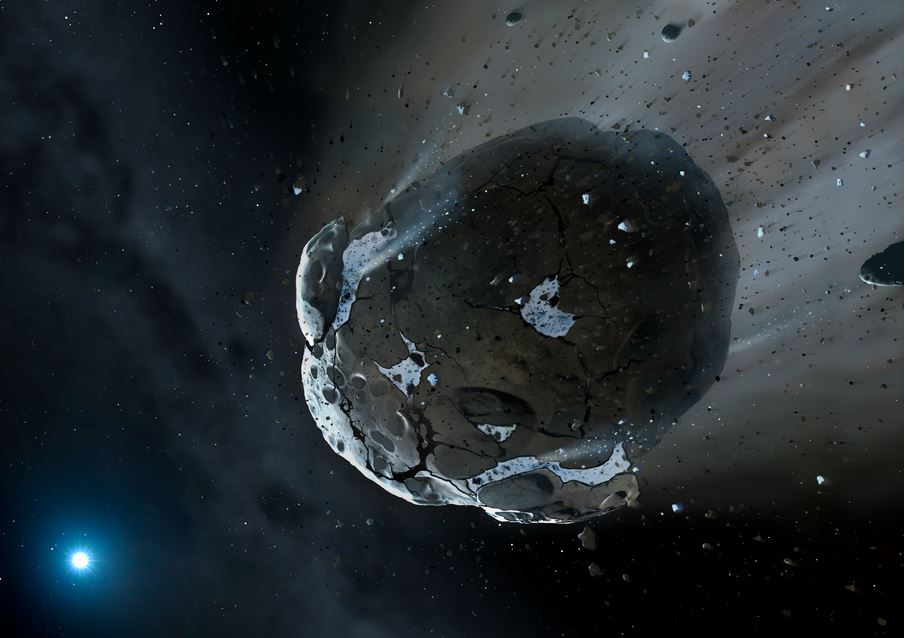Many asteroids and comets in space are full of water, which means an enormous number of planets in other planetary systems are likely to be not only water-rich, but also suitable for the formation of life as we know it, say scientists from the University of Warwick in England.
In a paper published in the Monthly Notices of the Royal Astronomical Society (citation below), Dr. Roberto Raddi and colleagues explained that water delivery via comets or asteroids is probably taking place in numerous other planetary systems, just as it happened on our planet.
The scientists, who work at the University of Warwick’s Astronomy and Astrophysics Group, say their study findings add further support to the likelihood of water being delivered to Earth-like exoplanets via such bodies to create habitable environments. (Exoplanets are planets outside our Solar System that orbit a star).

An artist’s impression of a rocky and water-rich asteroid being ripped apart by the powerful gravity of the white dwarf star. (Image: Mark A. Garlick, space-art.co.uk, University of Warwick)
Dry Earth became water-rich thanks to asteroids and comets
“Our research has found that, rather than being unique, water-rich asteroids similar to those found in our Solar System appear to be frequent.”
“Accordingly, many of planets may have contained a volume of water, comparable to that contained in the Earth.”
“It is believed that the Earth was initially dry, but our research strongly supports the view that the oceans we have today were created as a result of impacts by water-rich comets or asteroids.”
Asteroids and comets are different: Asteroids are made of metals and rocky material, while comets consist of ice, dust, rocky materials and organic compounds. When comets get nearer to the Sun, they lose material with each orbit because some of their ice melts and vaporizes. Asteroids usually remain solid, even when near the Sun.
Oxygen- & hydrogen-rich white dwarf
The astronomers studied observations made by the William Herschel Telescope in the Canary Islands, and detected a huge amount of oxygen and hydrogen in the atmosphere of a white dwarf called SDSS J1242+5226.
A white dwarf is a very small very dense star that is usually the size of a planet.
The amount of oxygen and hydrogen found provides evidence that a water-rich exo-asteroid (asteroid outside our Solar System) was disrupted and eventually delivered its water to the white dwarf.
The authors discovered that the asteroid was about the size of Ceres – 900 kilometers across – the largest asteroid in our Solar System.
Dr. Raddi said:
“The amount of water found SDSS J1242+5226 is equivalent to 30-35% of the oceans on Earth.”
When a comet or asteroid crashes into a planet or white dwarf, the hydrogen and oxygen mix into the atmosphere. Large amounts of both elements were detected in SDSS J1242+5226.
Co-author Boris Gänsicke, a professor at the University of Warwick’s Department of Physics, explained:
“Oxygen, which is a relatively heavy element, will sink deep down over time, and hence a while after the disruption event is over, it will no longer be visible.”
“In contrast, hydrogen is the lightest element; it will always remain floating near the surface of the white dwarf where it can easily be detected. There are many white dwarfs that hold large amounts of hydrogen in their atmospheres, and this new study suggests that this is evidence that water-rich asteroids or comets are common around other stars than the Sun.”
In March, scientists from the Niels Bohr Institute in Copenhagen and the Australian National University said there are billions of stars in the Milky Way with one to three planets in the Habitable Zone orbiting them. This means that our galaxy should be teeming with life.
Citation: “Likely detection of water-rich asteroid debris in a metal-polluted white dwarf,” R. Raddi, B. T. Gänsicke, D. Koester, J. Farihi, J. J. Hermes, S. Scaringi, E. Breedt and J. Girven. Monthly Notices of the Royal Astronomical Society. Published 6 May, 2015. DOI: 10.1093/mnras/stv701.

